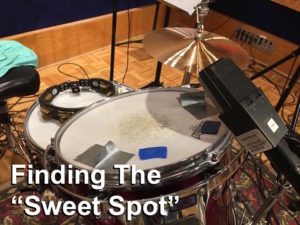- in Engineering , Microphones , Recording by Bobby Owsinski
Mic Placement Tips To Help You Find The “Sweet Spot”
 Mic placement may be the most important part of recording since a change of half-an-inch can sometimes make a huge difference in the sound. Finding that correct placement isn’t always easy though, so here’s an excerpt from my Recording Engineer’s Handbook 4th edition to give you some easy tips to find that “sweet spot” quickly.
Mic placement may be the most important part of recording since a change of half-an-inch can sometimes make a huge difference in the sound. Finding that correct placement isn’t always easy though, so here’s an excerpt from my Recording Engineer’s Handbook 4th edition to give you some easy tips to find that “sweet spot” quickly.
“Quickly finding a mic’s optimum position is perhaps the single most useful talent an engineer can have. Sometimes the search resembles questing for the Holy Grail as more trial and error is involved. That said, you should always trust your ears first and foremost by listening to the musician in the tracking room, finding the sweet spot, and placing your microphone there to begin. If you don’t like the resultant sound, then move the mic or swap it with another. EQ is the last thing to touch.
TIP: Mics cannot effectively be placed by sight, which is a mistake that is all too easy to make (especially after reading a book like this). The best mic position cannot be predicted, it must be found.
How to Find the “Sweet Spot”
How you listen to an instrument in the studio is just as important as the act of trying to capture its sound. As good as many microphones are, they’re still no match for our ears, and we can sometimes be fooled in what we’re hearing over the monitor speakers. Here are a few tips to help you listen more closely to the way the mic your using is capturing the sound.
- To place an omni microphone, cover one ear and listen with the other. Move around the player or sound source until you find a spot that sounds best.
- To place a cardioid microphone, cup your hand behind your ear and listen. Move around the player or sound source until you find a spot that sounds best.
- For a stereo pair, cup your hands behind both ears. Move around the player or sound source until you find a spot that sounds best.
Before you start swapping gear, know that the three most important factors in getting the sound you want are mic position, mic position and mic position.
Get the instrument to make the sound you want to record first, then use the cover-your-ears technique to find the sweet spot, position the mic, then listen. Remember that if you can’t hear it, you can’t record it. Don’t be afraid to repeat as much as necessary, or to experiment if you’re not getting the results you want.”
You can read more from The Recording Engineer’s Handbook and my other books on the excerpt section of bobbyowsinski.com.

